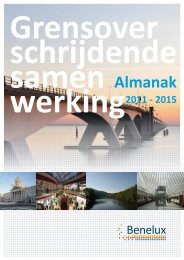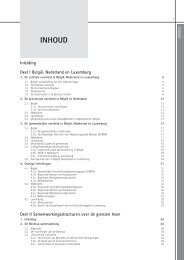The North Seas Countries' Offshore Grid Initiative - Initial ... - Benelux
The North Seas Countries' Offshore Grid Initiative - Initial ... - Benelux
The North Seas Countries' Offshore Grid Initiative - Initial ... - Benelux
You also want an ePaper? Increase the reach of your titles
YUMPU automatically turns print PDFs into web optimized ePapers that Google loves.
However, although PRIMES was used as a common basis, the governments each adapted it<br />
with their own best view. <strong>The</strong> assumptions underpinning those national contributions<br />
were quite different, resulting in different fuels emerging as dominant in different<br />
countries This is to be expected, with different countries having different technology<br />
preferences. This clearly has a significant impact on the infrastructure needs emerging<br />
from the market studies. In addition to the new offshore wind installations these market<br />
differences were the key drivers for increased interconnection and reinforcements in<br />
2030.<br />
<strong>The</strong> impact of these market differences is particularly evident in those countries<br />
presenting a gas-focussed portfolio, like Great Britain and Belgium. <strong>The</strong> assumed and<br />
agreed IEA fuel prices result in an economic production order of coal ahead of gas across<br />
the region. As a result, gas-fired generation units provide just 10% of electric energy<br />
(2030) even though they constitute over 20% of the installed capacity in the region.<br />
Conversely, coal-fired generation units provide 16% of electric energy despite making up<br />
just 9% of the total capacity installed. So, although gas capacity increases by 70%, and coal<br />
capacity decreases by 8%, the energy production behaves inversely with an 18% decrease<br />
for gas, but 190% increase for coal due to the impact of the assumed merit order. By<br />
implication, this will play a major role in the countries’ import / export positions and<br />
related infrastructure requirements.<br />
Clearly running this amount of coal will have an impact on CO emissions, which according<br />
2<br />
to the results stay constant between 2020 and 2030. It therefore follows that, without<br />
large-scale CCS integration, countries with the largest amounts of coal generation (e.g.<br />
Germany, Great Britain and the Netherlands) are and stay also the largest emitters of CO ,<br />
2<br />
although some movement between them can be observed between 2020 and 2030.<br />
In an energy only market and under this scenario it is doubtful whether gas-fired plant<br />
would have sufficient utilisation hours to be profitable with the assumed CO2 price and<br />
fuel prices of gas and coal.<br />
Thus, the resulting infrastructure for the Reference scenario should be re-evaluated, if the<br />
underlying production mix assumptions are changed in the light of the results presented<br />
in this study.<br />
Even though there may be differing assumptions underpinning the Reference scenario it<br />
provided an important insight to understand and evaluate the ten NSCOGI Governments’<br />
best views. Through this exercise, NSCOGI has made it possible to combine unique<br />
national knowledge with regional modelling capability. With this newly established<br />
regional cooperation with key stakeholders, NSCOGI is better prepared to provide future<br />
regional studies of this nature.<br />
<strong>The</strong> results show clearly that the region can benefit from ‘talking-to-the-neighbours’ or<br />
even cross-border cooperation on questions concerning both energy production unit<br />
planning and the associated infrastructure development.<br />
Page 60 of 142










